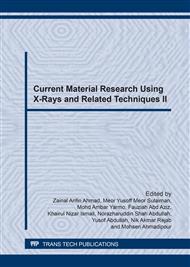p.17
p.23
p.28
p.33
p.37
p.42
p.47
p.52
p.57
Effect of Firing Temperature on Mechanical and Physical Properties of Porcelain Balls as Grinding Media
Abstract:
Porcelain balls as grinding media are produced by firing process of clay, quartz and feldspar mixtures. This application need high technological properties such as high compressive strength and hardness, wear resistance, low water absorption and excellent chemical resistance. These properties are associated with higher firing temperatures. The porcelain balls were prepared by mixing 30 wt.% clay, 40 wt.% feldspar and 30 wt.% quartz. The samples were sintered at 1200°C, 1230°C, 1250°C, 1270°C and 1300°C for 2 hours with heating rate of 3°C/min. Both green powder and fired samples were characterized by X-ray diffraction (XRD), X-ray fluorescence (XRF) and scanning electron microscopy (SEM).The properties of the fired samples were evaluated by compressive strength, hardness, shrinkage, water absorption, bulk density, and porosity measurement. Increasing of compressive strength, hardness and density are associated with increasing of firing temperatures. Porcelain balls PB1 and PB2 can be produced as grinding media with optimum mechanical and physical properties at firing temperature 1270°C and 1250°C, respectively.
Info:
Periodical:
Pages:
37-41
Citation:
Online since:
March 2017
Authors:
Keywords:
Price:
Сopyright:
© 2017 Trans Tech Publications Ltd. All Rights Reserved
Share:
Citation:


